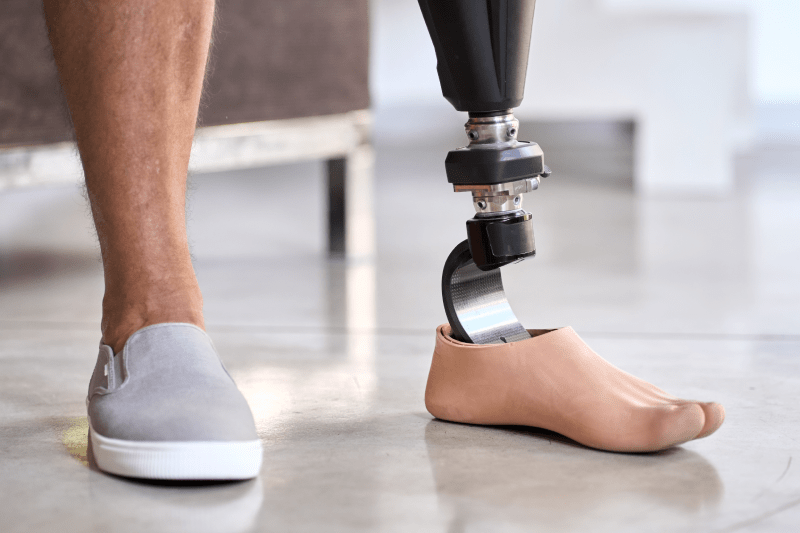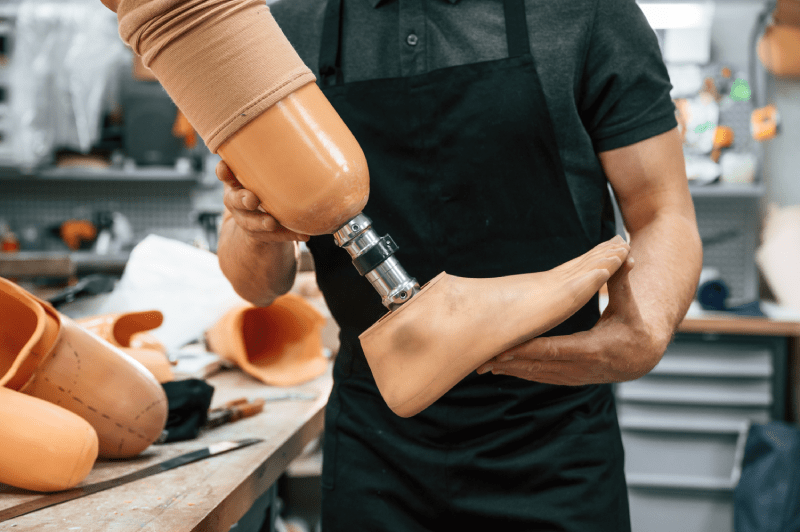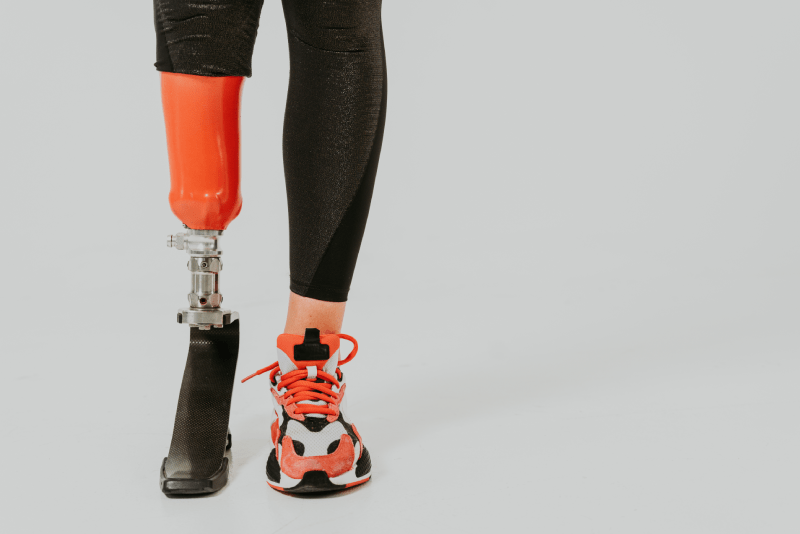What is an Ankle Replacement?
Ankle replacement is a surgical procedure for patients with advanced joint damage and pain. In this operation, the damaged ankle joint is removed and replaced with an artificial joint made of metal and plastic. This prosthesis aims to restore the ankle’s natural range of motion and relieve the patient’s chronic pain. The surgery is usually considered a solution for individuals who have lost joint function as a result of traumatic injuries, arthritis, or degenerative diseases.
Why is Ankle Replacement Surgery Popular in Turkey?
Turkey has become an increasingly popular destination for ankle replacement surgeries. The main reasons for this include its modern medical infrastructure, experienced surgeons who provide world-class service, and more affordable treatment options compared to Western countries.
Patients have the opportunity to both undergo a high-quality surgical operation and make their travel and accommodation expenses more affordable. In addition, the personalized service and quick appointment processes offered by Turkish hospitals also increase this popularity.
What is the Average Cost of Ankle Replacement Surgery in Turkey?
The cost of ankle replacement surgery in Turkey varies depending on many factors. On average, the cost of this surgery can range from £8,000 to £15,000. This price varies depending on the quality of the hospital where the surgery is performed, the surgeon’s experience, the brand of the prosthesis used, and whether post-operative physiotherapy and rehabilitation services are included. The price usually includes the length of stay in the hospital, doctor and nurse fees, and the operation itself. To clarify the price, it is recommended to request a detailed price breakdown from the hospital or clinic you choose.
What is Included in the Cost?
What is included in the cost of ankle replacement surgery in Turkey is generally as follows: the surgical procedure fee, the prosthesis implant itself, the equipment and materials used in the operating room, the fees of the anesthesiologist and the surgical team, accommodation and meal costs during the hospital stay, all necessary pre-operative tests (blood tests, X-rays, etc.), and the first post-operative check-ups. However, travel expenses, airport transfers, post-operative physiotherapy sessions, and accommodation costs are usually not included in the price, and it is important to get this information beforehand.
How Do I Know If I Am a Suitable Candidate for an Ankle Replacement?
Whether you are a suitable candidate for an ankle replacement is determined by a comprehensive evaluation by an orthopedic surgeon. Generally, patients with severe pain, limited mobility, and serious joint damage that restricts daily activities are suitable candidates.
These conditions often develop due to reasons such as arthritis or trauma. Suitable candidates are also those who are in good general health, do not carry a risk of infection, and are physically resilient to the surgical operation. Your doctor will evaluate the condition of your joint using imaging methods such as X-rays and MRI.
How Long Does the Surgery Take?
Ankle replacement surgery usually takes an average of 1.5 to 2 hours. The duration of the surgery may vary depending on the surgeon’s experience, the patient’s anatomical structure, and any additional procedures that may be required (for example, bone grafting). The pre-operative preparation and the first hours of the post-operative recovery process should also be evaluated outside of this time. This operation is a procedure that requires a meticulous and delicate surgical intervention, and the length of the duration indicates the surgeon’s attention to detail.
What is the Post-Surgery Recovery Process Like?
The post-operative recovery process usually begins in the hospital for the first few days. Patients take medication to control pain in the first few days after the operation. A few days after the surgery, they begin to get up and move slowly.
For the first few weeks, it is necessary to avoid putting weight on the ankle. The process of full recovery and returning to normal activities varies from person to person, but usually takes between 3 to 6 months. Physiotherapy is one of the most critical components of this process and is of great importance for regaining mobility.

How Should Hospitals in Turkey Be Chosen?
When choosing a hospital for ankle replacement surgery in Turkey, it is important to research their accreditations, the experience of their surgeons, and their success rates. Hospitals with international certifications (such as JCI) and that invest in modern medical equipment generally provide high standards of service. Comments and references from the clinic’s previous patients can also be helpful in the decision-making process. In addition, the quality of post-operative follow-up and physiotherapy services should also be taken into consideration.
Are There Risks and Complications of the Surgery?
Like any surgical procedure, ankle replacement surgery also has potential risks and complications. These include infection, blood clots, loosening or dislocation of the prosthesis, nerve damage, and the prosthesis’s lifespan being shorter than expected. These risks can be minimized with the right surgeon and hospital selection. A detailed evaluation of the risks before the surgery and strict adherence to the doctor’s instructions after the surgery increase the success rate.
How Important is Post-Surgery Physiotherapy?
Post-operative physiotherapy is vital for the success of ankle replacement treatment. Physiotherapy plays a critical role in regaining the ankle’s range of motion, strength, and function. Exercises performed with a specialist physiotherapist speed up the recovery process, reduce pain, and help the patient return to daily life activities more quickly. Physiotherapy sessions starting in the first few weeks after the surgery ensure the long-term and functional life of the prosthesis.
How Long Do You Stay in the Hospital After Ankle Replacement Surgery?
Patients undergoing ankle replacement surgery in Turkey usually stay in the hospital for 2 to 4 days after the operation. This period may vary depending on the evaluation of the surgeon and the patient’s health status. During the hospital stay, the patient is closely monitored, pain management is provided, and the first steps necessary for the healing process are taken. Before being discharged, patients are informed in detail about the exercises and care instructions they need to follow at home.
Can Payment Be Made with a Credit Card in Turkey?
Yes, many hospitals and clinics in Turkey accept international credit cards for ankle replacement surgery. It is possible to pay with common credit cards such as Visa and MasterCard. However, before making a payment, it is important to contact your bank and the hospital to get information about the exchange rate, additional fees, and limits that may apply to international transactions. Some hospitals may offer additional discounts for cash payments.
When is it Safe to Travel by Plane After Surgery?
Plane travel after ankle replacement surgery is generally safe after 2 to 4 weeks. However, this may vary depending on each patient’s healing process. To reduce the risk of blood clots during the flight, it is important to wear special compression stockings as recommended by your doctor and to move your legs frequently during the flight. For long flights, it is recommended to get information from your doctor about additional precautions to reduce risks before the flight.
What is the Lifespan of the Prosthesis?
Modern ankle prostheses are generally designed to last for 10 to 15 years. However, the lifespan of the prosthesis may be extended or shortened depending on the patient’s activity level, weight, and general health status. Regular check-ups and adherence to doctor’s recommendations are the most important factors for extending the lifespan of the prosthesis. In case of wear of the prosthesis, an additional surgery may be required to replace only the worn part of the prosthesis.
How Far in Advance Should I Book an Appointment for Surgery in Turkey?
The appointment process for ankle replacement surgery in Turkey varies depending on the chosen hospital and the surgeon’s availability. Generally, it is recommended to book an appointment for surgery a few weeks or a few months in advance. This allows enough time for all necessary pre-operative evaluations and tests to be done, and for travel and accommodation plans to be organized. For emergencies, hospitals may offer faster appointment processes.
Will There Be a Scar After Surgery?
In ankle replacement surgery, it is inevitable that there will be a scar in the surgical area due to the incision made by the surgeon. However, surgeons generally use modern surgical techniques and suturing methods to minimize the scar. The size and visibility of the incision scar depend on the patient’s skin type, wound healing rate, and the surgeon’s technique. Adhering to post-operative wound care instructions helps make the scar less noticeable.
What Languages are Spoken in Hospitals in Turkey?
In hospitals located in major cities in Turkey and especially those serving international patients, there is usually staff who speak various languages, especially English. Most hospitals offer translation services to help patients communicate throughout the treatment process. Before starting treatment, getting information about the language support services of the hospital you choose will eliminate possible communication problems.
What Preparations are Required Before Surgery?
Pre-operative preparations include an evaluation of the patient’s general health status. These preparations generally cover blood tests, electrocardiogram (ECG), chest X-ray, and other necessary tests. Your doctor will want to get detailed information about the medications you use before the surgery. Quitting smoking and reducing alcohol consumption a few weeks before the surgery will positively affect the healing process.
What Types of Prostheses are Used?
In ankle replacement surgeries in Turkey, high-quality prostheses produced according to international standards are generally used. These prostheses are made of biologically compatible materials such as titanium and polyethylene (plastic). The type of prosthesis is determined by the surgeon according to the patient’s joint, age, weight, and activity level. This choice is of critical importance for the long-term success of the treatment.
How Long Does it Take to Return to Normal Life After Prosthesis Surgery?
The process of returning to normal life after ankle replacement surgery varies from person to person. While most patients can return to light activities a few weeks after the surgery, full recovery and starting more strenuous activities can generally take 3 to 6 months. Full recovery requires regular physiotherapy and strict adherence to the surgeon’s instructions. A return to sports activities should be done with the doctor’s approval.
What are the Alternatives to Prosthesis Surgery?
The primary alternative to ankle replacement surgery is ankle fusion surgery. In this procedure, the damaged bones are fused and become a single bone, which relieves pain, but the joint’s range of motion is completely eliminated. Prosthesis surgery, on the other hand, aims to preserve joint mobility. Other alternatives include cortisone injections, physical therapy, and painkiller medications, but these are generally temporary solutions preferred in the early stages.
When Should the Decision for Surgery Be Made?
The decision for ankle replacement surgery should be made when other treatment methods (physiotherapy, medications, injections) have failed and the patient’s quality of daily life is seriously affected. If symptoms such as chronic pain, limited mobility, and difficulty walking are seriously restricting your daily activities, it is time to consult a specialist to evaluate the surgery option.
What are the Quality Standards in Turkey?
Turkey has a worldwide reputation in the field of health tourism, and many of its hospitals are certified by international accreditation organizations. These certifications show that the hospitals’ service quality, patient safety, and clinical processes comply with international standards. Turkish surgeons have generally been trained and have gained experience in Europe and the US. Therefore, the quality standards in surgeries performed in Turkey are quite high.
How is Post-Surgery Pain Controlled?
Post-operative pain control is very important for the patient’s comfort and quick recovery. During the hospital stay, doctors and nurses use various painkillers and methods to manage the pain. These medications can be given orally or intravenously. After being discharged, the patient is informed about the painkillers to use at home and what to do for pain control.

Can I Walk Again After Prosthesis Surgery?
Yes, the main goal of ankle replacement surgery is to enable the patient to walk again without pain and more comfortably. The post-operative physiotherapy and rehabilitation process help the patient regain their ability to walk. Although a walker or crutches are used initially, most patients start walking unassisted within a few months. The success of the surgery significantly increases the patient’s quality of life.
How Can I Find Accommodation in Turkey?
Most hospitals in Turkey have special patient services departments that help international patients with accommodation and travel arrangements. These departments can help patients and their companions find suitable hotels or apartments. You can also easily research and book accommodation options close to the hospital through online travel platforms.
What Should Post-Surgery Nutrition Be Like?
Post-operative nutrition is of great importance to support the healing process. Adequate protein, vitamin, and mineral intake speed up tissue repair and bone healing. Your doctor may recommend a special diet plan for you in the post-operative period. Generally, a diet rich in healthy fats and antioxidants that help reduce inflammation is preferred. Adequate fluid intake is also critical to prevent dehydration.
Does the Prosthesis Need to Be Replaced?
Yes, the ankle prosthesis may need to be replaced over time due to reasons such as wear or loosening. This “revision” surgery can be more complex than the first surgery. However, revision surgeries usually arise as an option when the prosthesis’s lifespan ends after 10-15 years. With regular check-ups, the condition of the prosthesis is monitored and can be intervened when necessary.
What is the Suitable Age Range for This Surgery?
The ideal age range for ankle replacement surgery is generally 50 and over. However, this may vary depending on the patient’s general health status and activity level. In younger patients, since the prosthesis needs to last for many years, alternatives such as fusion are more often evaluated. The surgeon will determine the most suitable treatment method by evaluating the patient’s specific situation.
Are There Agreements with Insurance Companies in Turkey?
For international patients, some hospitals in Turkey may have agreements with some international insurance companies. This allows a portion or all of the patient’s surgery costs to be covered by insurance. Before planning the surgery, it is important to contact your insurance company and the hospital you choose to get detailed information about this.
What is the Success Rate of the Surgery?
The success rate of ankle replacement surgery is quite high, generally over 90%. Success is measured by the reduction of the patient’s pain, the increase in their mobility, and their ability to return to daily activities. The most important factors affecting the success of the surgery include the surgeon’s experience, the patient’s general health status, and adherence to the post-operative rehabilitation program.
How Should Medication Be Used Before and After Surgery?
Before the surgery, it is important to consult your doctor about the use of some medications, such as blood thinners. These medications may need to be stopped before the surgery. After the surgery, you need to use the painkillers, antibiotics, and blood thinners prescribed by your doctor regularly. Strict adherence to the medication instructions reduces the risks of infection and clotting.
How Should Travel Arrangements Be Made?
When planning a trip for ankle replacement surgery in Turkey, it is important to organize flight dates, accommodation, and transfers to the hospital in advance. Most hospitals have units that help international patients with these arrangements. Since your mobility will be restricted in the post-operative period, make sure your airport transfers are suitable for your special needs, such as a wheelchair. Also, you may need to stay in Turkey for at least 10-14 days after the surgery.
When Do Walking and Exercises Start After Surgery?
For the first few weeks after the surgery, movement is done without putting weight on the ankle, usually with the help of crutches or a walker. The walking and exercise program after ankle replacement surgery usually starts a few days after the surgery. This program, under the supervision of a doctor and a physiotherapist, focuses on gradually increasing the ankle’s range of motion and strength. Walking exercises speed up the healing process and strengthen the muscles.
What Should Be Considered During the Healing Process?
The most important points to consider during the healing process include strictly following your doctor’s instructions, attending regular physiotherapy sessions, and taking care of the hygiene of the surgical area. Keeping the ankle elevated, applying ice, and using painkillers also help control swelling and pain. It is important to avoid alcohol and smoking as they can negatively affect the healing process.



